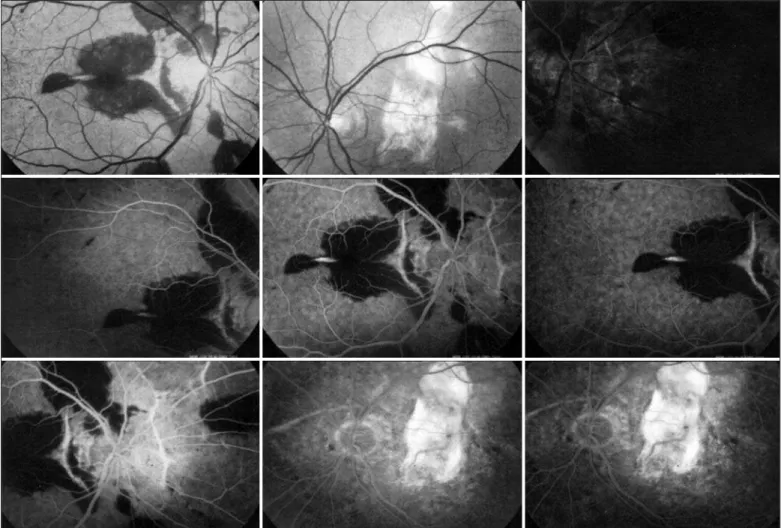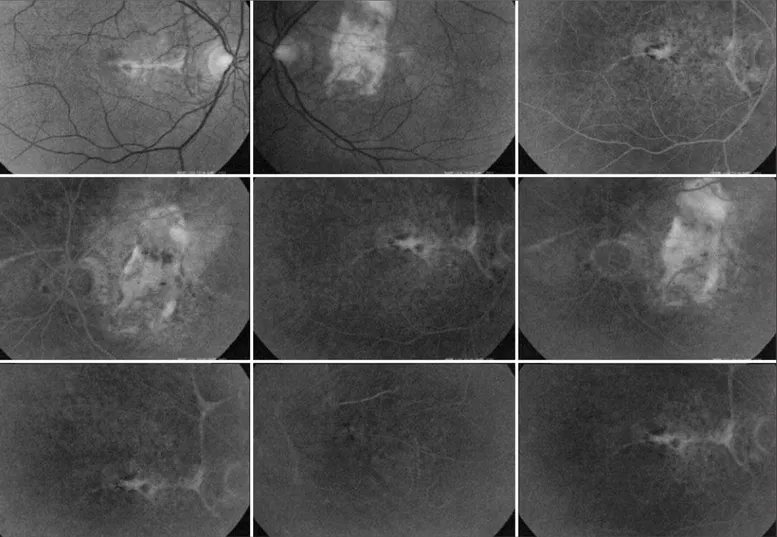Arq Bras Oftalmol. 2008;71(3):427-9
Uso de bevacizumab intravítreo em neovascularização coroidiana secundária
a síndrome de Grönblad-Strandberg: relato de caso
Trabalho realizado em Retina Division, Ophthalmology Department, Clínica de Olhos José Guilherme Pecego -Rio de Janeiro (RJ) - Brazil.
1Chefe do Setor de Retina e Vítreo da Clínica de Olhos José Guilherme Pecego - Rio de Janeiro (RJ) - Brazil. 2Mestre em Dermatologia pela Universidade Federal do
Rio de Janeiro - UFRJ - Rio de Janeiro (RJ) - Brazil. 3Médica da Clínica de Olhos José Guilherme Pecego e
da UFRJ - Rio de Janeiro (RJ) - Brazil.
Endereço para correspondência: Ricardo Miguel Japiassú. Rua Desembargador Isidro, 121 Apto. 202B -Rio de Janeiro (RJ) CEP 20521-160
Email: japimed@yahoo.com.br Recebido para publicação em 26.05.2007 Última versão recebida em 08.11.2007 Aprovação em 21.11.2007
Nota Editorial: Depois de concluída a análise do artigo sob sigilo editorial e com a anuência dos Drs. Ayrton Roberto Branco Ramos e Nilva Simeren Bueno de Moraes sobre a divulgação de seus nomes como revisores, agra-decemos suas participações neste processo.
Ricardo Miguel Japiassú1
Maria Augusta Castro Farias Japiassú2
Mariana Gomes Pecego3
Intravitreal bevacizumab in choroidal
neovascularization secondary to
Grönblad-Strandberg syndrome: case report
Keywords: Pseudoxanthoma elasticum; Angioid streaks; Choroidal neovascularization/ drug therapy; Angiogenesis inhibitors/therapeutic use; Case reports [Publication type]
Angioid streaks are commonly related to Grönblad-Strandberg syndrome, that often shows dermatological characteristics, such as pseudoxanthoma elasticum. Choroidal neovascularization is uncommon, often occurring after ocular trauma. This is a case report of the successful use of intravitreal bevacizumab for the treatment of choroidal neovascularization secondary to Grönblad-Strandberg syndrome.
ABSTRACT
RELATOS DE CASOS
INTRODUCTION
Grönblad-Strandberg syndrome is characterized by the development of yellowish confluent papules in the skin resembling peau d’orange, mainly on skinfolds, known as pseudoxanthoma elasticum. Angioid streaks are commonly related to this disease whereas choroidal neovascularization is uncommon(1-2), often occurring after ocular trauma.
Bevacizumab (Avastin®, Genentech) is an agent that inhibits the effects
of vascular endothelial growth factor (VEGF). Originally approved by the US Food and Drug Administration (FDA) for the treatment of colon cancer, bevacizumab has been used in an off-label manner to treat a variety of ocular diseases including choroidal neovascularization (CNV) secondary to age-related macular degeneration. More recently, bevacizumab has been offered as an alternative treatment option for patients with retinal vein occlusion and other causes, such as angioid streaks(1-5).
This is a case report of the successful use of intravitreal bevacizumab for the treatment of choroidal neovascularization.
CASE REPORT
428Intravitreal bevacizumab in choroidal neovascularization secondary to Grönblad-Strandberg syndrome: case Report
Arq Bras Oftalmol. 2008;71(3):427-9
The option was for intravitreal bevacizumab (Avastin®
/Ge-nentech, 1.25 mg) in OD due to known poor response of this disease to laser photocoagulation and photodynamic the-rapy. After one month, the patient’s visual acuity was 0.7 in OD and there was no evidence of macular hemorrhage nor leaking of the neovascular complex (Figure 2). After four months, there still was no evidence of neovascular complex leakage nor hemorrhage, and best corrected visual acuity still was 0.7.
DISCUSSION
Laser and photodynamic treatment for patients with choroi-dal neovascularization secondary to angioid streaks had statis-tically significant benefits in terms of retinal thickening and regression of the neovascular complex. There are crucial short-comings with these treatment options, however. With laser treatment, visual acuity gains were marginal and other sessions of laser treatment were often necessary, due to recurrence(2-3). In
patients with significant macular hemorrhages, treatment with
photodynamic therapy must be deferred until there is significant clearing of these hemorrhages.
We believe that bevacizumab can be a great choice of treat-ment for choroidal neovascularization secondary to angioid streaks, related or not to Grönblad-Strandberg syndrome.
RESUMO
As estrias angióides estão comumente relacionadas à síndrome de Grönblad-Strandberg, que se caracteriza ainda pela presença de alterações dermatológicas caracterizadas pelo pseudoxantoma elástico. A presença de neovascularização coroidiana nesses pacientes é incomum, ocorrendo geralmente após trauma ocular. Relatamos um caso de tratamento bem sucedido de neovascula-rização coroidiana secundária à síndrome de Grönblad-Strandberg com bevacizumab.
Descritores: Pseudoxantoma elástico; Estrias angióides;
Neovascularização coroidal/quimioterapia; Inibidores de angio-gênese/uso terapêutico; Relatos de casos [Tipo de publicação]
429
Intravitreal bevacizumab in choroidal neovascularization secondary to Grönblad-Strandberg syndrome: case Report
Arq Bras Oftalmol. 2008;71(3):427-9
REFERENCES
1. Rinaldi M, Dell’Omo R, Romano MR, Chiosi F, Cipollone U, Costagliola F. Intravitreal bevacizumab for choroidal neovascularization secondary to angioid streaks. Arch Ophthalmol. 2007;125(10):1422-3.
2. Bhatnagar P, Freund KB, Spaide RF, Klancnik JM Jr, Cooney MJ, Ho I, et al. Intravitreal bevacizumab for the management of choroidal neovasculariza-tion in pseudoxanthoma elasticum. Retina. 2007;27(7):897-902.
3. Lommatzsch A, Spital G, Trieschmann M, Pauleikhoff D. [Intraocular ap-plication of bevacizumab for the treatment of choroidal neovascularization secondary to angioid streaks]. Ophthalmologe. 2007;104(4):325-8. German. 4. Teixeira A, Moraes N, Farah ME, Bonomo PP. Choroidal neovascularization treated with intravitreal injection of bevacizumab (Avastin) in angioid streaks. Acta Ophthalmol Scand. 2006;84(6):835-6.
5. Pedersen R, Soliman W, Lund-Andersen H, Larsen M. Treatment of choroidal neovascularization using intravitreal bevacizumab. Acta Ophthalmol Scand. 2007;85(5):526-33.

